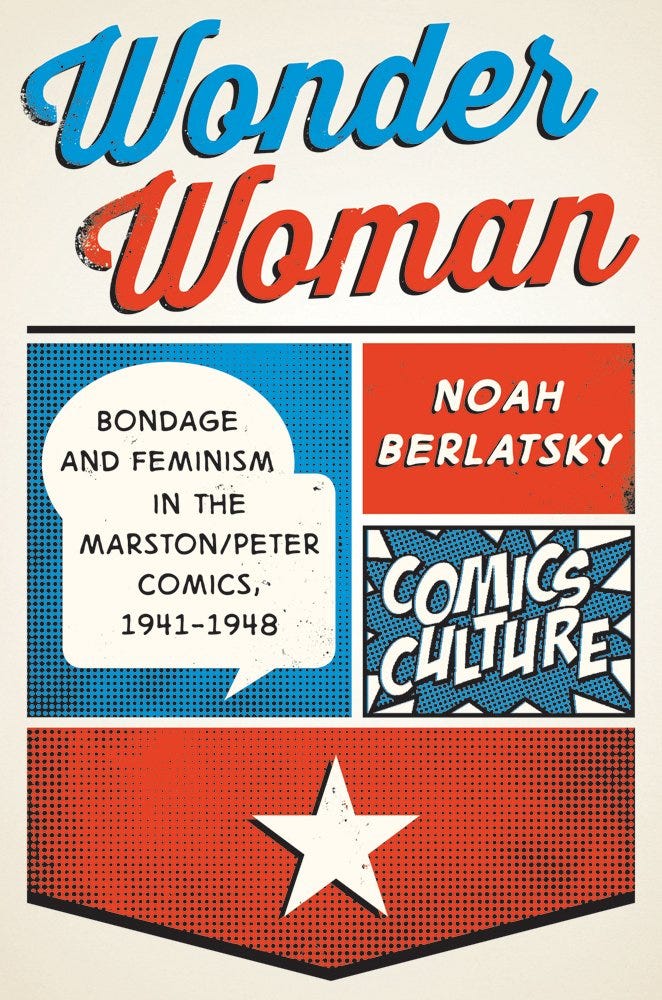Wonder Woman: Bondage and Feminism
I wrote a whole book on Wonder Woman, believe it or not.
Some ten years ago I published a book on the original Wonder Woman comics with Rutgers University Press. It’s called Wonder Woman: Bondage and feminism in the Marston/Peter Comics, 1941-1948, and it’s available from the press and from Amazon.
Here’s a summary:
William Marston was an unusual man—a psychologist, a soft-porn pulp novelist, more than a bit of a carny, and the (self-declared) inventor of the lie detector. He was also the creator of Wonder Woman, the comic that he used to express two of his greatest passions: feminism and women in bondage.
Comics expert Noah Berlatsky takes us on a wild ride through the Wonder Woman comics of the 1940s, vividly illustrating how Marston’s many quirks and contradictions, along with the odd disproportionate composition created by illustrator Harry Peter, produced a comic that was radically ahead of its time in terms of its bold presentation of female power and sexuality. Himself a committed polyamorist, Marston created a universe that was friendly to queer sexualities and lifestyles, from kink to lesbianism to cross-dressing. Written with a deep affection for the fantastically pulpy elements of the early Wonder Womancomics, from invisible jets to giant multi-lunged space kangaroos, the book also reveals how the comic addressed serious, even taboo issues like rape and incest.Wonder Woman: Bondage and Feminism in the Marston/Peter Comics 1941-1948 reveals how illustrator and writer came together to create a unique, visionary work of art, filled with bizarre ambition, revolutionary fervor, and love, far different from the action hero symbol of the feminist movement many of us recall from television.
And here’s a lovely blurb by comics scholar Peter Sattler.
I first read this book in manuscript while preparing to teach a course on superheroes and was a fan from the first pages. I didn’t realize, however, exactly how much I appreciated Noah Belatsky’s exploration of Wonder Woman until I read Jill Lepore’s recent “secret history” of the character and her creators.
Like Lepore, Berlatsky explores how these early superhero comics are connected to the broader histories of feminism, pacifism, and sexuality. Unlike the longer history, though, Berlatsky does not just reduce Marston and Wonder Woman to expressions of larger historical or cultural discourses. Berlatsky, as a writer and a thinker, is strongly committed to exploring what makes the Marston/Peter “Wonder Woman” comic books unique, idiosyncratic, experimental, and strange – that is, what turns them into expressions of unconventional and truly queer genius.
Berlatsky digs deep into Marston’s playful and playfully odd visions of bondage and freedom, submission and power, feminism and gender and love – linking all his claims to the way that these ideas take shape in particular Wonder Woman stories (and not just in the comics’ cultural or psychological context). He them takes all these ideas and plays with them himself, connecting Marston’s ideas and obsessions to Freud and Lacan, Eve Sedgwick and Judith Butler, Stan Lee and Stephanie Meyer.
As these last names indicate, Berlatsky’s own argument and his use of these other writers and thinkers is playful and suggestive – and sometimes even as funny and weird as the Wonder Woman comics he analyzes. This is not a by-the-numbers application of Theory X to Book Y to get Result Z. Instead, it is a series of strong close reading, linked to one another by occasionally wild but always potent digressions, each of which makes you think about Wonder Woman, the Amazons of Paradise Island, and the heroine’s potent Lasso of Truth in unexpected ways.
One warning: while Berlatsky’s book is generously illustrated, his extended readings of particular Wonder Woman stories will make you want to see the originals in full form (if only to answer the question, “Wait! Did they really show that?!”). Pick up inexpensive copies of the “Wonder Woman Chronicles” or the more pricey “Wonder Woman Archives.” Does Wonder Woman deserve that much space on your bookshelf? Does it merit a focused and far-reaching re-reading? Berlatsky shows us that the answer is, “By Hera, Yes!”
Again, you can purchase from the press and from Amazon. I hope some of you check it out!



I've been looking to get a copy of this. I consider it an important work of scholarship in this field.
I just ordered your book. I read the Jill Lepore book, but I’m interested in yours too.